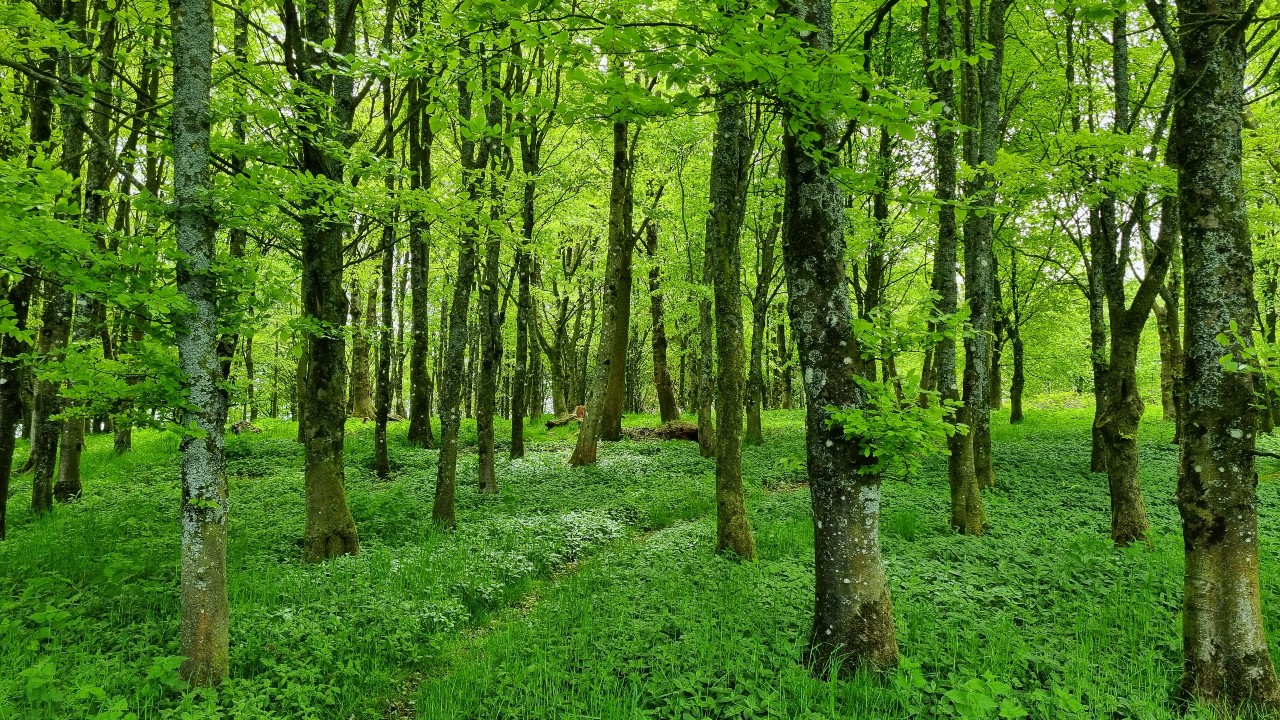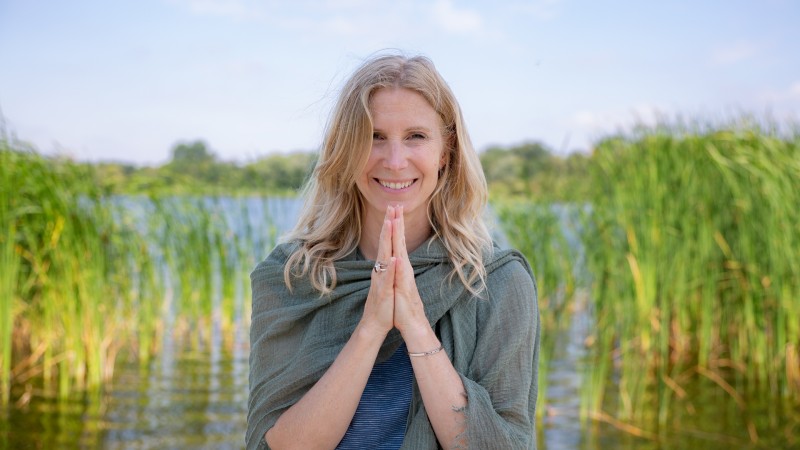The Japanese phrase, Shinrin Yoku, translates as ‘Forest Bathing’. Read on to discover 5 powerful benefits from this practice.
During this past year of lockdown many of the things we previously turned to for comfort and wellbeing were off limits. As travel was restricted and our local cafes and studios closed, the positive side was that many people rediscovered their local area and spent more time outside in nature.
One survey by Natural England reported that in May 2020 36% of respondents said they were spending more time outside during the pandemic than before. This rose to 46% in July 2020. Wildlife charities saw massive increases in website traffic and sales of plants and gardening equipment were reported to have boomed.
For many of us, nature provided a remedy for loneliness and worry, giving us a way of simultaneously disconnecting from screens or home-schooling, and reconnecting to a more natural part of ourselves we had perhaps long forgotten.
Instead of hopping on a busy train for the morning commute, there was now the option of taking a woodland walk, or a nature-filled hike instead of an artificially-lit gym. You could say that nature provided therapy for us, which is something advocates of Shinrin Yoku or Forest Bathing have promoted for years.
What is Forest Bathing?
‘Forest Bathing’ or ‘Nature Therapy’ comes from the Japanese Shinrin Yoku. It was developed in Japan in the 1980s as a way to help stressed out city-dwellers unwind. The term describes the experience of mindfully taking in the forest atmosphere during a leisurely walk, and has become an important cornerstone of preventative healthcare in Japan and the East. In Europe and the USA, we might also know it as ecotherapy.
It sounds so simple, but as well over half of the world’s population now live in busy cities, it’s becoming more and more difficult for humans to interact with the natural landscape we’re so intimately evolved with. Children who grow up in towns and cities are also increasingly at risk of nature deficit disorder – a phrase coined by author Richard Louv, best known for his book Last Child In The Woods.
Researchers and therapists say many cases of depression, ADHD, OCD and anxiety can be linked to a deficit in nature or ‘vitamin N’ in our lives, whereas spending time in nature has been shown to have innumerable benefits for both body and mind.
To fully experience the benefits of Shinrin Yoku, it’s well worth taking a trip to the nearest forest. If that’s not an option however, you can still connect with nature in your local park, and by stepping out into your garden or balcony. If outside space is limited, bring nature indoors with house plants, and decorate with greens and browns to evoke a sense of being in the forest when you’re at home.
Read on for five of forest bathing’s most powerful benefits and how you can connect with them.
1. Reduction in Depression and Depressive Tendencies
Those who spend more time in nature seem to have an enhanced sense of wellbeing, and far lower rates of depression. Studies show that getting out into nature for a day can have a significant impact on mood and mental health, greatly reducing signs and symptoms of depression and anxiety. Perhaps it’s the natural daylight or an opportunity to slow down, but if a day in the forest can show results this powerful, it’s definitely worth trying as a natural therapy for mood and mind.
Put it in to practice
Start your Forest Bathing practice by choosing a safe place to walk, without distractions such as your phone or other technology. So often, the social media platforms on our phones can be a source of anxiety, so if it’s safe to do so, you could even leave your phone at home or turn it to ‘silent’ mode. Try to forget about taking photos or sharing your experience online, and let this be the beginning of a sacred practice that involves just you and the forest.
2. Immune System Benefits and Virus Prevention
Whilst walking through the woods, we inhale incredibly beneficial phytoncides every time we breathe. Phytoncides are natural chemicals emitted from trees and plants that have the natural benefit of protecting both the plant and us from illness.
Stand in the middle of a forest and take a deep breath in. The phytoncides you inhale have antibacterial and antifungal qualities, and trigger an increase and activation of a type of white blood cell called ‘NK cells’, or ‘natural killer’ cells. These cells kill tumour and virus infected cells in the body, and their effects can leave a beneficial imprint long after the initial visit to the forest is over. Studies show increased NK cell activity for over thirty days after a three-day forest trip, and researchers are currently exploring whether exposure to forests can indeed help prevent certain types of cancer. The good news is that you don’t have to spend weeks in the woods to experience the prolonged immune benefits from phytoncides, as a day trip to a forest park can actually increase NK cell activity for more than seven days after.
Put it in to practice
As you begin to walk through the forest, focus on your sense of smell; what scents do you notice? Do some trees give off more powerful scents than others? Is there a particular smell that seems familiar?
3. Enhanced Happiness, ‘Awe’ and Spiritual Connection
A feeling of ‘awe’ is something we rarely experience in day-to-day life, but is one that can have life-affirming benefits, and is usually only truly experienced in nature. ‘Awe’ is a mysterious emotion linked to positivity and wonder, and is said to be one of the emotions that can help us feel more spiritually connected to a ‘higher power’. Call it ‘god’, ‘the universe’, or ‘the divine’, nature seems to expand our awareness and sense of belonging in the world, which in turn can inspire an enhanced sense of wellbeing, generosity and connection to humanity. Studies with older adults showed that a weekly 15 minute ‘awe walk’ led to increased positive emotion and prosocial emotions such as compassion and gratitude.
Put it in to practice
The next step in your Forest Bathing practice is to pause when you find a suitable spot in the forest. Look up at the canopy of branches and leaves above you – without expectation – and allow yourself to simply gaze in wonder for a few moments. Even the simple act of looking upwards through the trees can have a profound perspective-shifting impact.
4. Enhanced Creativity
Walking in general seems to boost creativity hugely, and walking in nature enhances the effects even more. Stanford University researchers found that going for a walk can improve creativity by 60%, and famous creatives like Virgina Woolf, Beethoven, and Pablo Picasso were well known to have enjoyed long walks in nature. Using the sense of sight in the forest can induce an effect known as ‘soft fascination’, according to researchers and psychology professors Rachel and Stephen Kaplan, helping our busy and often frazzled minds recover by returning them to a state of calm, introspection and restoration.
When we’re stressed, our sense of sight leans towards a ‘tunnel-vision’ – like state, but taking in the natural and gently changing surroundings of leaves and branches, animals and rays of sunlight can help our nervous systems re-set, providing more brain-space to be creative and pro-active, instead of reactive.
Put it in to practice
Find a place to sit and practice the ‘What’s moving?’ Forest Bathing technique. Simply cast your eyes over the forest floor and notice what is moving, and what’s in stillness. Is there a gentle breeze making the plants and flowers playfully dance? Are there birds visiting their nests? Is there a sense of strength and stillness amongst the heavy oak tree trunks?
5. Renewed Relationship With Nature
Perhaps one of the most simple effects time spent in nature can have upon us, is a renewed appreciation for its beauty and power. We may have come a long way from living in as close a relationship with nature as we did a few thousand years ago, but we can still reconnect to the plants and trees around us, and cultivate a meaningful relationship with them.
Put it in to practice
When you come to the end of your Forest Bathing walk, take a moment to thank the forest for having you. Perhaps continue your practice by choosing a specific tree to visit each week, or a spot to return to and watch as the colours change through the seasons.
Help us Grow a Forest!
We’re planting a tree for everyone who joins us for our live meditations


